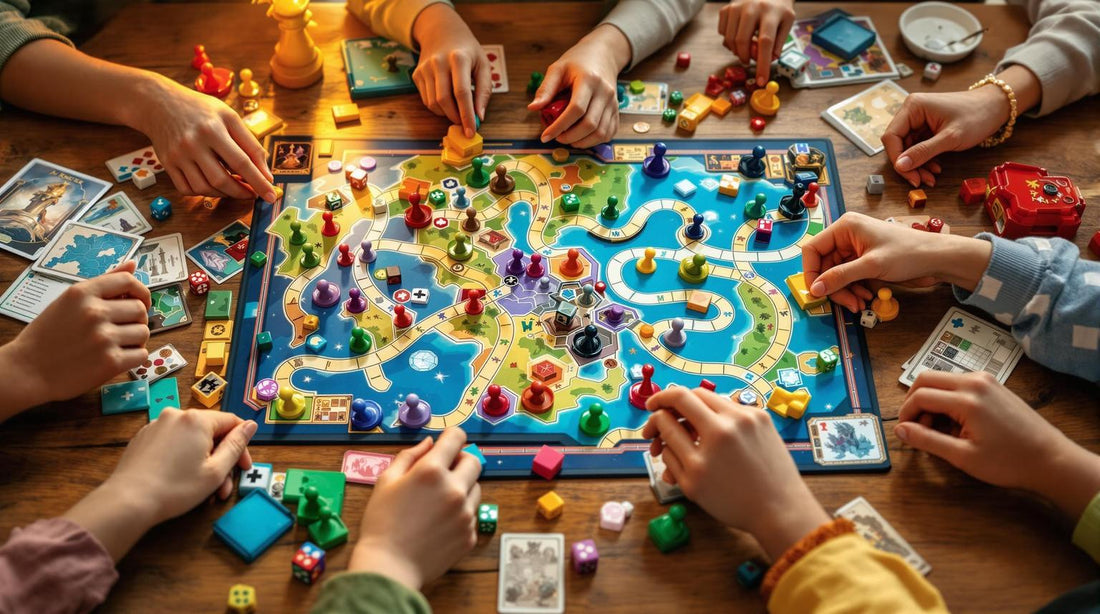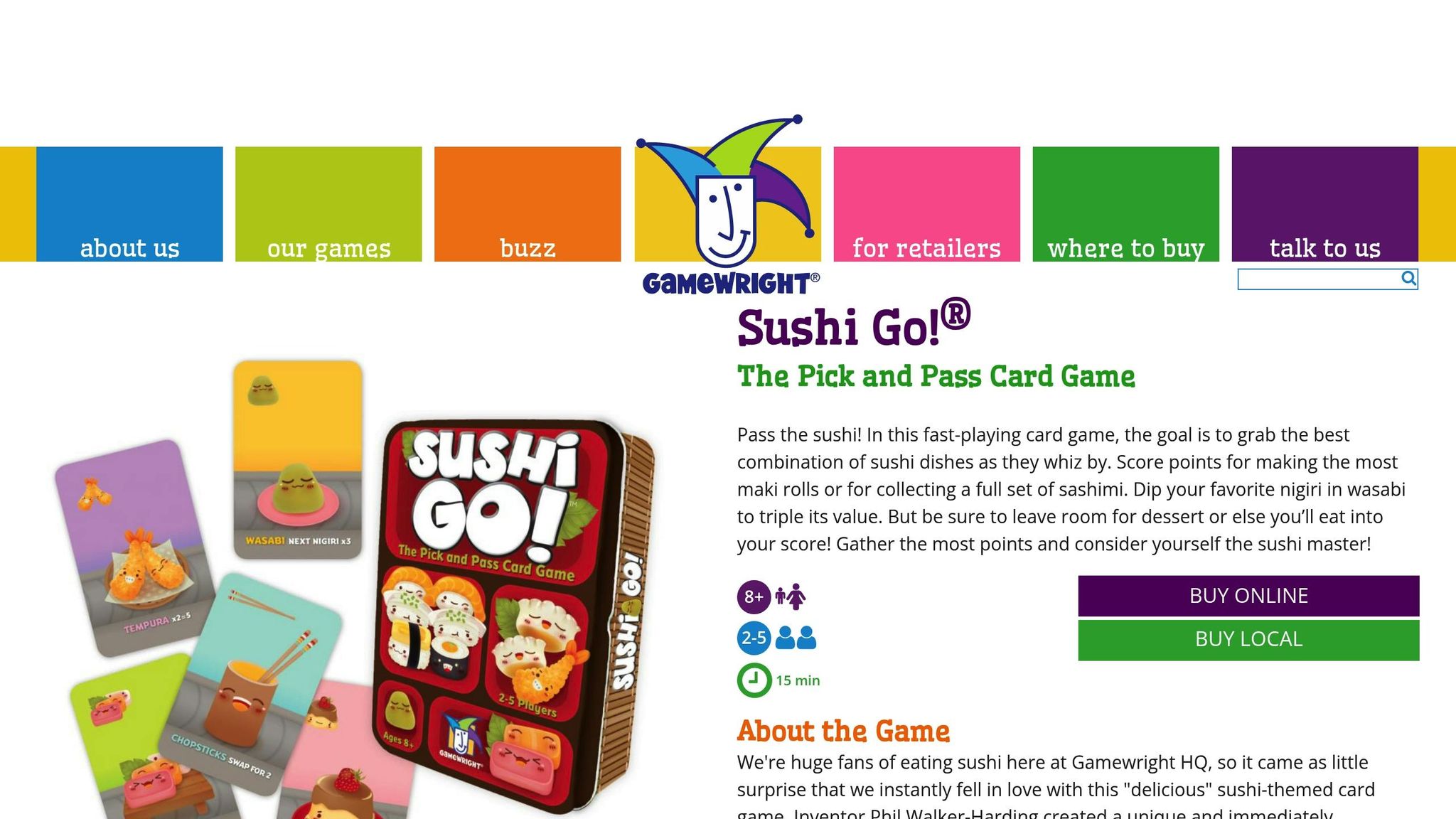Discover the Best Board Games for Every Player

Best Tabletop Games for All-Age Family Fun
Looking for the perfect family board game? Whether you're bonding with kids, teens, or grandparents, board games offer a great way to connect, laugh, and learn together. Here's what to keep in mind when choosing one:
- Simple Rules, Engaging Gameplay: Easy to learn but fun for everyone.
- Cooperative vs. Competitive: Decide if your family prefers teamwork or friendly rivalry.
- Durability and Accessibility: Sturdy pieces, clear visuals, and kid-friendly designs matter.
Here are three top picks for family game nights:
- Carcassonne: Build medieval landscapes with strategy and creativity.
- Herd Mentality: Fun group game about guessing the majority opinion.
- Sushi Go: Quick, portable card game with adorable sushi-themed art.
Use the comparison table below to find the best fit for your family.
Top 20 Favorite Board Games for the Family
What Makes a Good Family Board Game
Choosing the right family board game means finding one that brings everyone together while offering fun and learning opportunities. Here are three key factors to consider when picking a game that fits your family:
Simple Rules, Engaging Gameplay
Look for games with straightforward rules that still offer plenty of depth. Games that are "easy to learn but challenging to master" are ideal because they let kids join in while keeping adults entertained. Features to look for include:
- Optional rules to adjust difficulty as needed
- Multiple ways to win, keeping things interesting
- A mix of luck and strategy to balance the experience for all players
Cooperative or Competitive Play
Modern board games often let you choose between working together or competing, making it easier to match the game's style to your family's vibe:
| Play Style | Benefits | Best For |
|---|---|---|
| Cooperative | Encourages teamwork and communication | Families with younger kids or mixed ages |
| Competitive | Builds strategy skills and sportsmanship | Families with older children |
| Hybrid | Combines teamwork with a bit of rivalry | Larger groups with varied preferences |
Durability and Accessibility
Well-made components can make a big difference in how much you enjoy a game. Keep an eye out for:
- Sturdy materials: Pieces and cards that can handle plenty of use
- Kid-friendly design: Pieces that are easy for small hands to handle
- Clear visuals: Bold colors and readable text for all ages
- Organized storage: Built-in organizers to keep everything in place
Games that allow for adjustable difficulty levels are especially great for families, as they grow with your kids' skills and keep everyone engaged.
Best Board Games for Families
Here are three tabletop games that bring families together, offering fun and engaging experiences for all ages. These picks balance easy-to-learn rules with enough depth to keep everyone entertained, from kids to grandparents.
Carcassonne: Build a Medieval World
With over 9,000 Amazon reviews and a 4.7/5 rating, Carcassonne has been a family favorite for more than 20 years. Players take turns placing tiles to create a medieval landscape filled with cities, roads, and farms, making it both strategic and visually appealing.
Why it works for families:
- Easy-to-understand rules: place a tile, claim a feature.
- Encourages teamwork by building a shared map.
- Expansions keep the game fresh for repeated play.
Herd Mentality: Think Like the Group

Perfect for groups of 4 to 20 players, Herd Mentality is all about guessing what the majority will think. Questions like “What’s the best ice cream flavor?” spark lively conversations, with points earned when answers match the group.
What makes it family-friendly:
- No trivia or factual knowledge required.
- Encourages empathy and understanding through discussions.
- Simple scoring system using cow tokens.
Sushi Go: Pass and Play Cards

This card-drafting game is quick, portable, and packed with charm. With its sushi-themed artwork and fast-paced "pick and pass" mechanics, Sushi Go keeps everyone involved in every round, making it perfect for families on the go.
| Feature | Why It’s Great for Families |
|---|---|
| Compact tin packaging | Easy to pack for trips or storage. |
| Simultaneous card selection | Keeps everyone engaged, no waiting. |
| Scoring uses basic math | Reinforces addition skills for kids. |
These games are great options to create memorable family game nights with something for everyone to enjoy.
sbb-itb-1ed942f
Game Comparison Guide
Looking for the perfect game for your family? This comparison chart highlights key details to help you choose the right fit:
Game Features Chart
| Game | Players | Age | Play Time | Setup | Difficulty | Player Interaction | Key Feature |
|---|---|---|---|---|---|---|---|
| Carcassonne | 2-5 | 7+ | 30-45 min | 5 min | Medium (2.3/5) | High | Tile placement and shared map building |
| Ticket to Ride | 2-5 | 8+ | 45-60 min | 10 min | Medium (2.3/5) | Moderate | Route building with indirect competition |
| Sushi Go | 2-5 | 8+ | 15-20 min | 2 min | Easy (1.2/5) | High | Card drafting |
| Codenames | 2-8+ | 14+ | 15-20 min | 3 min | Easy (1.3/5) | Very High | Team-based word association |
| Herd Mentality | 4-20 | 10+ | 20-30 min | 1 min | Easy (1.0/5) | Very High | Social interaction and group thinking |
What Makes These Games Family-Friendly?
These games are designed with family gatherings in mind. They offer:
- Varied layouts and play styles to keep each session fresh.
- Built-in mechanisms to level the playing field, so everyone can enjoy.
- Inclusive gameplay - Sushi Go, for instance, keeps everyone engaged with simultaneous card selection.
If you're short on time, Herd Mentality and Sushi Go are great options thanks to their quick setup and shorter playtimes. For families looking to dive into a more strategic experience, Ticket to Ride is a fantastic choice that encourages shared decision-making.
Games like Herd Mentality and Codenames are excellent for larger gatherings, offering scalable gameplay that ensures no one feels left out.
How to Pick Your Family's Next Game
When choosing your family's next game, keep these practical tips in mind to make your game nights enjoyable and hassle-free.
Match Ages and Game Length
Pick a game that fits your family's attention span and the time you have. For example, quick games like Sushi Go! work well for busy weeknights, while weekends can be perfect for longer, more involved games. Don’t forget to account for setup and cleanup time when planning your sessions.
Choose Game Style
The type of game you choose - competitive, cooperative, or a mix of both - can greatly influence your family's experience. Here's a quick breakdown:
| Style | Best For | Examples | Benefits |
|---|---|---|---|
| Competitive | Families okay with winning/losing | Ticket to Ride, Sushi Go! | Encourages strategic thinking |
| Cooperative | Mixed skill levels, younger players | Pandemic, Castle Panic | Promotes teamwork and minimizes conflicts |
| Hybrid | Flexible play groups | Castle Panic (with variants) | Combines both play styles for variety |
Player Count and Replay Value
Games with high replay value can keep family game nights fresh and engaging. Look for games with features like:
- Different setup options to keep things interesting
- Multiple strategies to win
- Adjustable difficulty levels to match your group’s preferences
Want to try before you buy? Many libraries now let you check out board games, and board game cafes or platforms like Board Game Arena are great for testing games. Finally, choose themes that match your family’s interests without sacrificing the fun or quality of gameplay.
Conclusion
Purchase Options
Finding family-friendly games is simple with retailers like Brain Games (brain-games.com). Their 2-week exchange policy lets you try new games without worry. When browsing their international selection, think about how many players the game supports and whether expansions are available to keep the fun going.
Building Family Connections
A 2022 study from the University of Wisconsin-Madison found that families playing board games together twice a week saw a 37% boost in overall family satisfaction. The same research, led by Dr. Emily Thompson, showed a 42% improvement in communication skills among kids aged 8-14 over six months. These results highlight the benefits of spending quality time together.
The games we've highlighted help create memories through shared experiences. They spark laughter, teach valuable lessons, and connect generations - all without screens. These moments often stick with children into adulthood, continuing the bonds these games help build.
FAQs
Here are answers to some common questions about picking the right family games:
What are the best family board games, and how should we pick one?
Look for games that suit your family's interests and dynamics. Keep these factors in mind:
- Time available: How long can everyone commit to playing?
- Number of players: Make sure the game works for your group size.
- Age range: Choose something enjoyable for both kids and adults.
- Interaction style: Decide if your family prefers competition or teamwork.
How are modern board games different from the classics?
Modern games often focus on teamwork and strategy rather than relying solely on luck. They’re designed to appeal to a wide range of ages and usually include:
- Opportunities for shared decisions.
- High-quality, engaging components.
- Options for cooperative gameplay.
Can game night be educational?
Absolutely! Pick games that naturally include learning elements. For example:
- Games like Ticket to Ride teach spatial reasoning and planning.
- Many games help with math, reading, or problem-solving skills.
- Strategic thinking becomes second nature during play.
How can we include players of different ages?
- Team up younger players with adults using team-based rules often found in modern games.
- Choose games with visual elements that capture kids’ attention but still challenge adults.
- Look for games with adjustable difficulty to keep everyone engaged.






